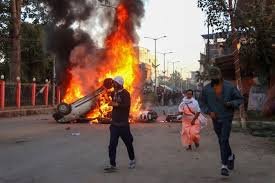Once a dominant force in Maharashtra politics, Uddhav Thackeray’s Shiv Sena (UBT) is struggling for survival following its disastrous performance in the state assembly polls. . Leading the party through a tumultuous coalition with the Congress and NCP, Uddhav’s leadership has failed to prevent the rise of Eknath Shinde’s faction
By PC Bureau
Uddhav Thackeray, once the leader of Maharashtra’s most iconic political dynasty, finds himself at a critical juncture after a dismal performance in the state assembly polls. The Shiv Sena (UBT) faction, under his leadership, will now struggle to maintain its relevance in a state where its influence was once unmatched. With the rise of rival factions, waning voter support, and internal discord, Thackeray faces a series of formidable challenges that could define his political career and the future of his party.
The Shiv Sena’s decline under Uddhav Thackeray contrasts starkly with its glorious past under Bal Thackeray, the party’s firebrand founder. Uddhav’s ascension to power marked a shift in the Sena’s identity—from an aggressive, Hindutva-driven force to a more moderate, governance-focused outfit. As Chief Minister of Maharashtra from 2019 to 2022, Uddhav won praise for his handling of the COVID-19 pandemic and his administrative acumen.
However, the very coalition that brought him to power—the Maha Vikas Aghadi (MVA), an alliance with the ideologically diverse Congress and NCP—sowed discord within the party. Many Shiv Sena loyalists, particularly those in the rank-and-file, viewed the alliance as a betrayal of the Sena’s Hindutva roots. This dissatisfaction set the stage for the rebellion led by Eknath Shinde in mid-2022.
Eknath Shinde’s revolt split the Shiv Sena, taking the majority of its MLAs and grassroots support with him. Backed by the BJP, Shinde became Chief Minister, leaving Uddhav to lead a diminished faction. This schism also triggered a bitter legal battle over the party’s name and its iconic bow-and-arrow symbol, which the Election Commission ultimately awarded to Shinde’s faction.
The Shiv Sena (UBT)’s rout highlights the extent of the damage caused by the split. Despite Uddhav’s efforts to portray himself as the custodian of the Sena’s legacy, the poll results indicate a severe erosion of support, even in constituencies that were once party bastions.
The setbacks have intensified scrutiny on Uddhav’s leadership, with critics questioning whether his moderate approach and alliance with the MVA are alienating the Sena’s core supporters.
Challenges Facing Uddhav Thackeray
1. Rebuilding the Party
The Shiv Sena’s grassroots network, once its greatest strength, has been severely weakened by the split. Many cadres have shifted allegiance to Shinde’s faction, which they view as more aligned with Bal Thackeray’s original vision of aggressive Hindutva and Marathi pride. Uddhav now faces the Herculean task of reconnecting with these disillusioned workers and rebuilding a cohesive organizational structure.
2. Ideological Dilemma
Uddhav’s leadership has steered the Sena away from its hardline Hindutva stance toward a more centrist position. While this shift helped secure the MVA coalition, it has alienated a significant section of the Sena’s traditional voter base, who now see Shinde’s faction as the true inheritors of Bal Thackeray’s legacy. Balancing the demands of the MVA alliance with the need to reclaim the Sena’s identity remains one of Uddhav’s most pressing challenges.
3. Alliance Dependence
The Shiv Sena (UBT)’s electoral strategy is heavily reliant on the MVA alliance, but this partnership is fraught with challenges. The NCP’s recent split, with Ajit Pawar joining the BJP-led government, has weakened the alliance. Moreover, the Congress’s resurgence in some regions raises questions about its willingness to concede seats to its allies in future elections.
4. Legal and Financial Constraints
The loss of the Shiv Sena’s official symbol and name to the Shinde faction has dealt a severe blow to Uddhav’s campaign efforts. Additionally, financial resources, previously abundant due to the party’s dominance, have dwindled, making it harder to mount effective election campaigns.
Rising Rivals and Internal Strife
While Uddhav grapples with rebuilding his faction, his rivals are consolidating power. Eknath Shinde, with BJP support, has established himself as a dominant force in state politics. The BJP, under Devendra Fadnavis’s leadership, continues to grow its footprint in Maharashtra, leaving little room for the Shiv Sena (UBT) to maneuver.
Within the Shiv Sena (UBT), discontent is brewing among cadres who believe that the party’s survival hinges on adopting a more aggressive posture. Uddhav’s moderate approach, while appealing to urban voters, has done little to energize the rural base or attract younger voters.
Despite the setbacks, Uddhav Thackeray has remained defiant. He has emphasized the need for patience and resilience, citing historical examples of political comebacks. He has also pledged to contest the 2025 Maharashtra Assembly elections on all 288 seats, signaling his determination to rebuild the party.
Uddhav has begun reaching out to grassroots workers through rallies and public meetings, aiming to rekindle the Sena’s traditional appeal of Marathi pride. He has also called for greater unity within the MVA, urging allies to present a united front against the BJP and the Shinde faction.
For Uddhav Thackeray, the stakes couldn’t be higher. The son of Bal Thackeray, he carries the weight of a political legacy that defined Maharashtra for decades. His leadership will be judged not only by his ability to win elections but also by his capacity to reinvent the Shiv Sena in a rapidly changing political environment.
The coming months will be crucial as Uddhav charts a path forward, balancing the demands of his party’s traditional supporters with the realities of coalition politics. Whether he emerges as a resilient leader capable of reclaiming his party’s lost glory or fades into political obscurity will depend on his ability to adapt, innovate, and inspire in these challenging times.












